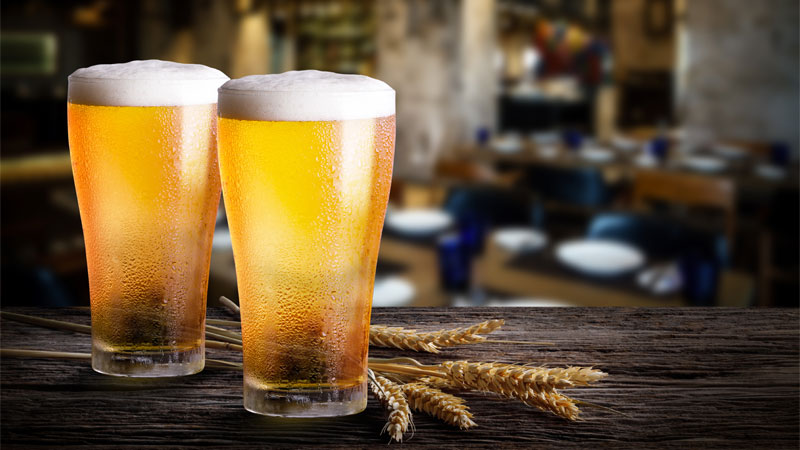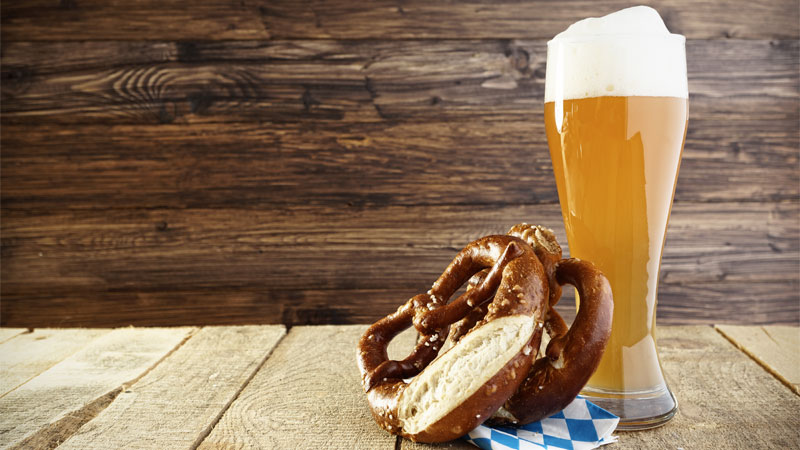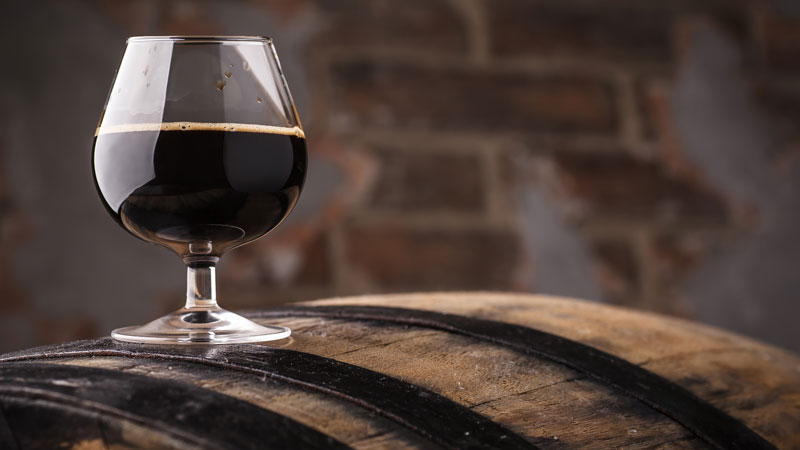First brews can be exhilarating: You’re about to make alcohol! The same stuff you’d happily pay for at the bar, you’re about to make in your kitchen, like a Prohibition-fighting, bathtub-brewing speakeasy owner.
Brewing is fun, but it’s also work. It involves heavy lifting, temperature monitoring, and a whole lot of waiting. It finally culminates in five gallons of magical liquid poured into a sterile container with yeast that will turn into beer — two or three weeks later.
When it’s finally time to crack open a bottle of homebrew, the first-time brewer faces her moment of truth: absolute amazement, or sheer disappointment.
Don't Miss A Drop
Get the latest in beer, wine, and cocktail culture sent straight to your inbox.Having a successful first brew day starts with your recipe. A good rule of thumb is to start with relatively simple styles that are also forgiving — in other words, beer styles that naturally cover up potential flaws.
For that first brew day to turn into more brew days, and maybe even a few competitive medals, try these three styles that are as beginner-friendly as they are delicious. Although we can’t guarantee success, the styles and the recipes below should put you on the path to hearing your friends say, “Yeah, I’d drink a bunch of this.”
If You Love a Classic: American Wheat Ale

IPAs and pale ales are wildly popular at the local bottle shop, but they are not ideal for a first-time brew. Two major factors lead to IPA disappointment: Hop blends that come in kits don’t have the pungent, fresh flavor of juicy pints from the brewery down the street. And, if a beer doesn’t ferment out completely — meaning yeast quit metabolizing sugar before it was all gone — the beer will be too sweet and bready to showcase the hops.
American wheat ales are quintessential American craft, using citrusy hops like Centennial, Citra, and Cascade, as well as American yeast. Compared to an IPA’s bitter bite, American wheat beers balance hops with a rounder mouthfeel.
When sourcing a homebrew kit, especially for hoppy styles like this, skip the gift shops and grocery stores and look for homebrew suppliers like Northern Brewer or More Beer (or Brooklyn Brew Shop for those interested in all-grain homebrewing). Old hops will not only have a stale, lifeless flavor, they can also cause the off flavor isovaleric acid, which tastes and smells like stinky cheese or — gross! — feet.
Whatever style you choose for your first brew day, avoid additives. Kits with added adjuncts like chocolate, peppers, coffee, or dried fruits include these ingredients to camouflage off flavors because the kit is expected to make off flavors. There are plenty of chipotle IPA kits at big-box stores such as Bed Bath & Beyond or Target, but the finished beer will taste like a full-blown pepper fest, and leave almost no recognizable grain or hop character.
Good Go-To: German Hefeweizen

Hefeweizen, or Hefe for short, is a German-style ale popular in warm-weather months because of its drinkability and average alcohol content (4 percent to 5.5 percent ABV). The German yeast varieties used give distinct fruity and spicy aromas, like banana and clove. This helps cover up trace off-flavors, like diacetyl, which has a buttery aroma and mouthfeel, and acetaldehyde, which gives off green apple or grass aromas. These unwanted compounds result from unfinished fermentation or stressed yeast.
A grist consisting of at least 50 percent malted wheat creates a purposeful fullness on the palate that can mask the sweetness of a beer that didn’t ferment fully. Plus, the yeast is forgiving when it comes to fermentation and will create its signature banana and clove flavors anywhere in the 62-to-72-degree Fahrenheit range.
For Chef-y Types: Porter and Stout

For fans of roasty flavors, like coffee and chocolate, porters and stouts are a great place to start. Dark malt provides strong aromas and flavors that hide potential fermentation flaws, like the aforementioned diacetyl (buttery) and acetaldehyde (green apple). Specialty malts like crystal malt, chocolate malt, roasted barley, or black patent malt create complex flavor combinations that avid home cooks will appreciate as they try their hand at brewing.
Process lovers might also enjoy the extra step of steeping specialty grains before adding malt extract and boiling. This method requires attention to detail and temperature control, giving your first-ever brew day a little more spectacle.
Recipes for Your First Brew Day*
*These recipes have been modified from their original versions by Mandy Naglich. Credit: Jamil Zainasheff / byo.com
American Wheat Ale
Ingredients
- 7 lb (3.2 kg) Briess wheat liquid malt extract or similar (3 °L)
- 4.15 oz Willamette pellet hops (0.83 oz/24 g of 5% alpha acids)
- 0.5 oz Citra pellet hops (11% alpha acids)
- 0.5 oz Cascade pellet hops (5% alpha acids)
- Wyeast 1010 (American Wheat) or Fermentis Safale US-05 yeast
Directions
Mix enough water with the malt extract to make a pre-boil volume of 5.9 gallons (22.3 L). Stir thoroughly to dissolve the extract and bring to a boil.
Add the Willamette hops and boil for 60 minutes. Add the Citra and Cascade hops just before shutting off the burner. Chill the wort rapidly to 65°F (18°C) and let the break material settle. Rack to the fermenter and pitch yeast.
Ferment in a cool place like a closet or basement (you’re looking for a temp around 65°F) until the beer attenuates fully (bubbling and any sign of activity will completely stop at this time). With healthy yeast, fermentation should be complete in a week. Rack to a keg and force carbonate or rack to a bottling bucket, add priming sugar, and bottle. Target a carbonation level of 2.5 volumes.
Finished beer stats: OG = 1.052 (12.8 °P) FG = 1.012 (3.0 °P) IBU = 20 SRM = 5 ABV = 5.3%
German Hefeweizen
Ingredients
- 4.85 lb wheat liquid malt extract (4 °L)
- 0.65 oz Hallertau pellet hops (4% alpha acids)
- Wyeast 3068 Weihenstephan Weizen or White Labs WLP300 (Hefeweizen Ale) yeast
Directions
Mix enough water with the malt extract to make a pre-boil volume of 5.9 gallons (22.3 L). Stir thoroughly to dissolve the extract and bring mixture to a boil.
Add the bittering hops and boil for 60 minutes.
After the boil is complete, chill the wort rapidly to 62°F (17°C) and let the break material settle. Rack (transfer) wort to the fermenter and pitch the yeast.
Ferment in a cool place like a closet or basement (you’re looking for a temperature of low 60s°F) until the beer attenuates fully (bubbling and any sign of activity will completely stop at this time). With healthy yeast, fermentation should be complete in a week. Rack to a keg and force carbonate, or rack to a bottling bucket, add priming sugar, and bottle. Target a carbonation level of 2.5 to 3 volumes.
Finished beer stats: OG = 1.049 (12.1 °P) FG = 1.013 (3.2 °P) IBU = 13 SRM = 5 ABV = 4.8%
American Stout
Ingredients
- 8.51 lb Light Liquid malt extract 2 °L (or similar)
- 14.46 oz Briess black barley 500 °L (or similar)
- 10.93 oz crystal malt 40 °L (or similar)
- 10.93 oz Briess dark chocolate malt 420 °L (or similar)
- 1.16 oz Horizon pellet hops (13% alpha acids)
- 0.85 oz Centennial hops (9% alpha acids)
- White Labs WLP001 (California Ale) or Wyeast 1056 (American Ale) yeast
Directions
Mill or coarsely crack the black barley, crystal malt, and dark chocolate malt and place loosely in a grain bag (or make a bag with cheesecloth). Steep the bag in 1 gallon (~4 liters) of water at roughly 170°F (77 °C) for 30 minutes. Lift the grain bag out of the steeping liquid and rinse with warm water. Allow the bag to drip into the kettle while you add the malt extract. Do not squeeze the bag. Add enough water to the steeping liquor and malt extract to make a pre-boil volume of 5.9 gallons (22.3 L). Stir thoroughly to dissolve the extract and bring mixture to a boil.
Add the Horizon hops and boil for 60 minutes. Add the Centennial hops with 5 minutes left in the boil. Chill the wort to 67°F (19°C) and add yeast. Ferment at 67°F (19°C) until the yeast drops to the bottom of the fermenter (all bubbling and yeast activity will stop at this point).
Allow the yeast to settle and the stout to mature in the fermenter for two days after fermentation appears finished. Rack to a keg and force carbonate, or rack to a bottling bucket, add priming sugar, and bottle. Target a carbonation level of 2.5 volumes.
Finished beers stats: OG = 1.072 (17.5 °P) FG = 1.017 (4.4 °P) IBU = 73 SRM = 48 ABV = 7.2%
